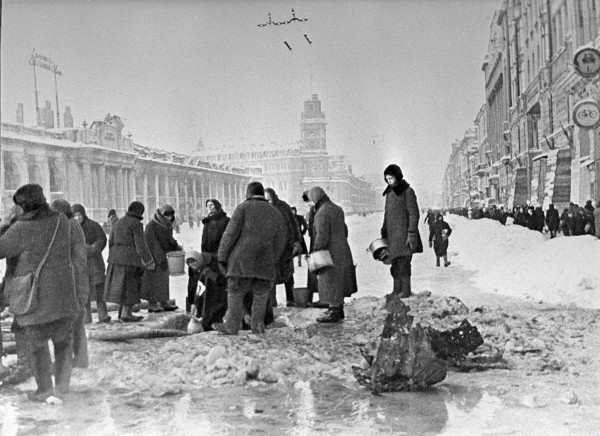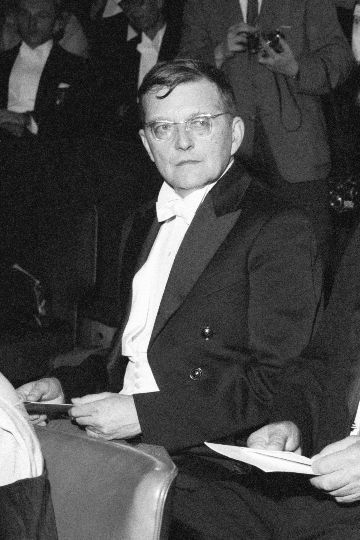Symphony under Siege: Dmitri Shostakovich and the Fight Against Nazism
Posted by Pete on 9th Aug 2020
The composer Dmitri Shostakovich died today in 1975. Decades earlier, during WW2, his Seventh Symphony became a global beacon of resistance to the Nazi empire when it was performed by a half-starved orchestra during the siege of Leningrad.

Musical creation and radical politics have often gone hand in hand.
Paul Robeson made singing into an art of political solidarity, Woody Guthrie wove anti-fascism and labour union politics into lots of his WW2-era folk ballads, and the movement against the American war in Vietnam inspired rebellious music all over the world.
But rarely has music been so embedded in political struggle as Dmitri Shostakovich’s Symphony No. 7 – the Leningrad Symphony.

Born in St Petersburg in 1906, Shostakovich was already a well-known composer by the early years of the Soviet Union.
A restive musical spirit, he just managed to survive the years of the Great Terror during the late-1930s while many other Soviet artists fell victim to Stalin’s malice.
Shostakovich was working in his hometown, known as Leningrad at the time, when Hitler launched his monstrous invasion of the USSR in June 1941.
He was unable to enlist in the Red Army on medical grounds, so helped the war effort as a firefighter at the Leningrad Conservatory of Music where he worked.
With the Soviet frontline collapsing, Leningrad was soon besieged by the Nazis and their Finnish allies who were invading Russia from the north.
The siege would ultimately last more than three years.
It was perhaps the most brutal in human history, bringing immense hardship – aerial bombardment, freezing conditions, mass starvation – on ordinary Leningraders. Over half a million civilians perished.
In the midst of all this horror, Shostakovich began to work on his Seventh Symphony while under regular bombardment and just miles from the Soviet frontline.
He composed the first three movements while still inside the embattled city.
In late summer 1941, Shostakovich was playing through the first couple of movements to some friends when he had to call a break due to a German bombing raid.

He assured his audience that, once he’d taken his wife and kids down to the air raid shelter, he’d return to complete the piece.
Recognising the role that Shostakovich's project could have in raising morale, the Soviet government had him evacuated to complete the Symphony’s fourth and final movement.
What was to become the longest of all his works, the 7th Symphony usually takes around 75 minutes to perform
Upon finishing it in December 1941, Shostakovich named it in tribute to his defiant city, 'Leningrad'.
The Leningrad Symphony found immediate fame worldwide.
Performed for Britain on the BBC and America on NBC, it was a morale-booster for Russia’s allies, heard as musical proof of the Soviet people’s defiance and will to overcome Hitler.
But by far its most iconic performance was in Leningrad itself, still under siege, in August 1942.
Of the original 40 members of the Leningrad Radio Orchestra, only 15 remained in the city, the rest dead or fighting on the frontlines.
These half-starved musicians, reinforced by whatever others could be found, gathered in Leningrad’s Grand Philharmonia Hall on 9th August 1942.
The Red Army bombarded Nazi positions beforehand – to ensure they’d bunker down and shut up for the duration of the performance.
And then this besieged orchestra played Shostakovich’s Seventh for all of its 75 minutes.

Loudspeakers broadcast the music across Leningrad and out towards the Axis positions, letting the enemy know that the city was not yet broken, nor would it ever be.
In all its aspects, the Leningrad Symphony was a punch in the face for Hitler.
His racial hatred of the Soviet people cast them as savage and cultureless.
But here was a musical masterpiece being performed, in direct defiance of the Nazi hordes, in one of the great cultural centres of the Russian world.
The Nazis had promised to destroy Leningrad and Shostakovich’s Symphony let them know that they were going to fail.
In the 1930s and 1940s, Hitler’s barbaric vision for the world provoked a wide range of courageous opposition, from the sporting boycott of the Berlin Olympics to the armed defiance of the Warsaw Ghetto.
Through music, Nazism was defied by Shostakovich and his Leningrad Symphony – perhaps the most inspiring moment in the radical history of orchestra.
